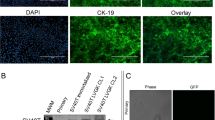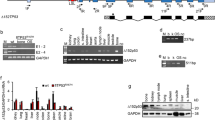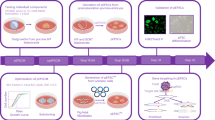Abstract
The transition from basic to clinical cancer research for a number of experimental therapeutics is hampered by the lack of a genetically malleable, large animal model. To this end, we genetically engineered primary porcine cells to be tumorigenic by expression of proteins known to perturb pathways commonly corrupted in human cancer. Akin to human cells, these porcine cells were quite resistant to transformation, requiring multiple genetic changes. Moreover, the transformed porcine cells produced tumors when returned to the isogenic host animal. The ability to now rapidly and reproducibly genetically induce tumors of sizes similar to those treated clinically in a large mammal similar to humans in many respects will provide a robust cancer model for preclinical studies dependant on generating large tumors.
This is a preview of subscription content, access via your institution
Access options
Subscribe to this journal
Receive 50 print issues and online access
$259.00 per year
only $5.18 per issue
Buy this article
- Purchase on Springer Link
- Instant access to full article PDF
Prices may be subject to local taxes which are calculated during checkout




Similar content being viewed by others
References
Anderson LJ, Jarrett WF . (1968). Lymphosarcoma (leukemia) in cattle, sheep and pigs in Great Britain. Cancer 22: 398–405.
Armbruster BN, Banik SS, Guo C, Smith AC, Counter CM . (2001). N-terminal domains of the human telomerase catalytic subunit required for enzyme activity in vivo. Mol Cell Biol 21: 7775–7786.
Bos JL . (1989). Ras oncogenes in human cancer: a review. Cancer Res 49: 4682–4689.
Brown DG, Johnson DF . (1970). Diseases of aged swine. J Am Vet Med Assoc 157: 1914–1918.
Chudnovsky Y, Adams AE, Robbins PB, Lin Q, Khavari PA . (2005). Use of human tissue to assess the oncogenic activity of melanoma-associated mutations. Nat Genet 37: 745–749.
Cifone MA, Fidler IJ . (1980). Correlation of patterns of anchorage-independent growth with in vivo behavior of cells from a murine fibrosarcoma. Proc Natl Acad Sci USA 77: 1039–1043.
Dewhirst MD, Thrall D, Macewen E . (2000). Spontaneous Pet Animal Cancers. In: Teicher BA (ed). Tumor Models in Cancer Research. Humana Press: Totowa, NJ pp 565–589.
Fiebig H-H, Burger AM . (2000). Tumor Xenografts and Explants. In: Teicher BA (ed). Tumor Models in Cancer Research. Humana Press: Totowa, NJ, pp 113–141.
Goessel G, Quante M, Hahn WC, Harada H, Heeg S, Suliman Y et al. (2005). Creating oral squamous cancer cells: a cellular model of oral-esophageal carcinogenesis. Proc Natl Acad Sci USA 102: 15599–15604.
Hahn WC, Counter CM, Lundberg AS, Beijersbergen RL, Brooks MW, Weinberg RA . (1999). Creation of human tumour cells with defined genetic elements. Nature 400: 464–468.
Hahn WC, Dessain SK, Brooks MW, King JE, Elenbaas B, Sabatini DM et al. (2002). Enumeration of the simian virus 40 early region elements necessary for human cell transformation. Mol Cell Biol 22: 2111–2123.
Hamad NM, Elconin JH, Karnoub AE, Bai W, Rich JN, Abraham RT et al. (2002). Distinct requirements for Ras oncogenesis in human versus mouse cells. Genes Dev 16: 2045–2057.
Kendall SD, Adam SJ, Counter CM . (2006). Genetically engineered human cancer models utilizing mammalian transgene expression. Cell Cycle 5: 1074–1079.
Kendall SD, Linardic CM, Adam SJ, Counter CM . (2005). A network of genetic events sufficient to convert normal human cells to a tumorigenic state. Cancer Res 65: 9824–9828.
Levine AJ . (1997). p53, the cellular gatekeeper for growth and division. Cell 88: 323–331.
Lim KH, Counter CM . (2004). Leveling the playing field. Mol Cell 15: 491–492.
Nesbit CE, Tersak JM, Prochownik EV . (1999). MYC oncogenes and human neoplastic disease. Oncogene 18: 3004–3016.
O'Hayer KM, Counter CM . (2006). A genetically defined normal somatic human cell system to study ras oncogenesis in vitro and in vivo. In: Abelson JN, Simon MI (eds). Methods in Enzymology. In: Balch WE, Der CJ, Hall A (eds). Regulators and effectors of small GTPases: Ras family, vol. 407. Academic Press: San Diego. pp 637–647.
Oxenhandler RW, Berkelhammer J, Smith GD, Hook Jr RR . (1982). Growth and regression of cutaneous melanomas in Sinclair miniature swine. Am J Pathol 109: 259–269.
Pathak S, Multani AS, McConkey DJ, Imam AS, Amoss Jr MS . (2000). Spontaneous regression of cutaneous melanoma in sinclair swine is associated with defective telomerase activity and extensive telomere erosion. Int J Oncol 17: 1219–1224.
Perez J, Garcia PM, Bautista MJ, Millan Y, Ordas J, Martin de las Mulas J . (2002). Immunohistochemical characterization of tumor cells and inflammatory infiltrate associated with cutaneous melanocytic tumors of Duroc and Iberian swine. Vet Pathol 39: 445–451.
Rangarajan A, Hong SJ, Gifford A, Weinberg RA . (2004). Species- and cell type-specific requirements for cellular transformation. Cancer Cell 6: 171–183.
Shay JW, Wright WE . (2002). Telomerase: a target for cancer therapeutics. Cancer Cell 2: 257–265.
Stewart SA, Weinberg RA . (2000). Telomerase and human tumorigenesis. Semin Cancer Biol 10: 399–406.
Swanson KS, Mazur MJ, Vashisht K, Rund LA, Beever JE, Counter CM et al. (2004). Genomics and clinical medicine: rationale for creating and effectively evaluating animal models. Exp Biol Med (Maywood) 229: 866–875.
Van Dyke T, Jacks T . (2002). Cancer modeling in the modern era: progress and challenges. Cell 108: 135–144.
Vincent-Naulleau S, Le Chalony C, Leplat J-J, Bouet S, Bailly C, Spatz A et al. (2004). Clinical and histopathological characterization of cutaneous melanomas in the melanoblastoma-bearing libechov minipig model. Pigment Cell Res 17: 24–35.
Wargovich MJ, Satterfield W, Price RE, Stephens LC, Coghlan L . (1991). Hepatic pathology of the colon carcinogen, azoxymethane, in Hanford-Moore miniature pigs. J Comp Pathol 105: 271–278.
Weinberg RA . (1991). Tumor suppressor genes. Science 254: 1138–1146.
Xie W, Evans RM . (2002). Pharmaceutical use of mouse models humanized for the xenobiotic receptor. Drug Discov Today 7: 509–515.
Yeh E, Cunningham M, Arnold H, Chasse D, Monteith T, Ivaldi G et al. (2004). A signalling pathway controlling c-Myc degradation that impacts oncogenic transformation of human cells. Nat Cell Biol 6: 308–318.
Acknowledgements
We thank C Linardic, D Kendall, G Ivaldi, J Beever, N Hamad, I York, J Sedivy and M Dewhirst for advice or assistance and AR Means for support. We also thank the Histopathology Laboratory, College of Veterinary Medicine, University of Illinois. This work was supported by grants from the Elsa U Pardee Foundation, Duke Comprehensive Cancer Center, NIH (CA94184) and USDA (2002-35205-12712). CMC is Leukemia and Lymphoma Scholar, LAR is supported by a Cargill Research Fellowship. SJA is supported by a DoD Predoctoral Training Fellowship (BC050468).
Author information
Authors and Affiliations
Corresponding authors
Rights and permissions
About this article
This article is cited by
-
Swine models for translational oncological research: an evolving landscape and regulatory considerations
Mammalian Genome (2022)
-
A novel method for isolation and culture of primary swine gastric epithelial cells
BMC Molecular and Cell Biology (2021)
-
Porcine pancreatic ductal epithelial cells transformed with KRASG12D and SV40T are tumorigenic
Scientific Reports (2021)
-
Non-murine models to investigate tumor-immune interactions in head and neck cancer
Oncogene (2019)
-
A porcine model of osteosarcoma
Oncogenesis (2016)



